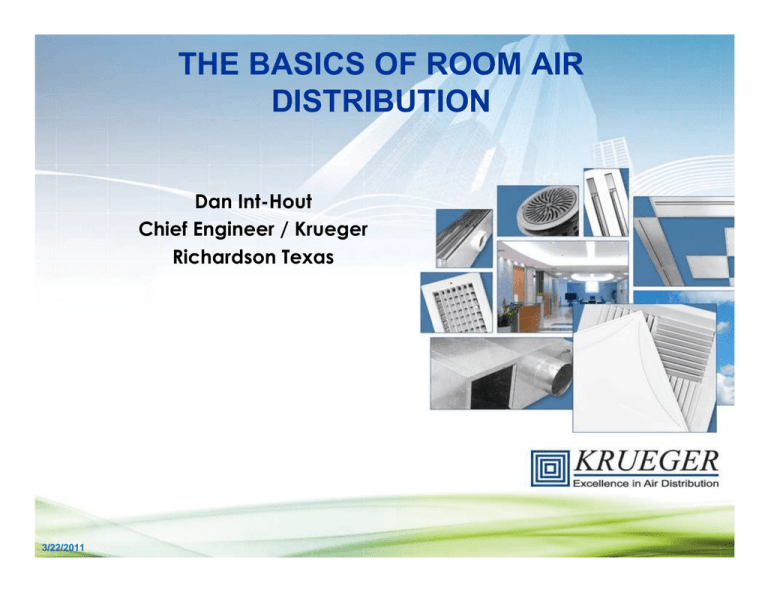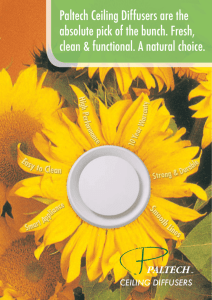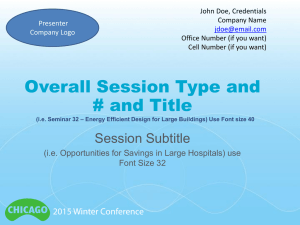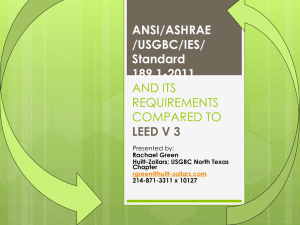the basics of room air distribution
advertisement

THE BASICS OF ROOM AIR DISTRIBUTION Dan Int-Hout Chief Engineer / Krueger Richardson Texas 3/22/2011 Why Air Distribution? What are we trying to accomplish with air distribution system? • Provide Occupant Thermal Comfort • Provide sufficient ventilation to meet codes • Control Latent loads (Humidity) What supplies the air we are Distributing? • Most systems provide air from overhead and attempt to provide “well mixed” spaces. • Sources include rooftops, VAV, WSHP, Chilled beams, etc • Some systems are partially or fully stratified. • Lets start by understanding basic terminology: Understanding The Terminology Primary Air Jets - Air jets from free round openings, grilles, perforated panels, ceiling diffusers and other outlets can be defined by three variables. • Throw • Drop • Spread Understanding The Terminology THROW DROP Understanding The Terminology Spread - is defined as the divergence of the airstream in a horizontal or vertical plane after it leaves the outlet. 50 fpm 22.5 Typical 100 fpm 22.5 150 fpm Understanding The Terminology Coanda Effect - a negative or low pressure area is created between the moving air mass and the ceiling at or near the supply air outlet. This low pressure area causes the moving air mass to cling to and flow close to the ceiling surface and increases the throw. Coanda Effect Understanding The Terminology Understanding primary air jet variables enables • Accurate prediction of room air flow • Improvement of thermal comfort • Proper selection of grilles, registers and diffusers • Adherence with ASHRAE Ventilation Std 62.1 is a Leed PREREQUISITE, and is required by many codes. Understanding The Terminology The Basis of Catalog Performance Data • Throw – The horizontal or vertical axial distance an airstream travels after leaving an air outlet, usually assumes a surface adjacent to the air outlet • Pressure – Can be total pressure or static pressure • Sound – Can be either NC or Octave Band data Throw • Throws are cataloged for 150, 100 and 50 fpm terminal velocities. • Throws should be selected so that jets do not collide, but have sufficient projection for the area to be served. 150fpm 100fpm 50fpm 7 – 8 – 12 Pressure PS PT Pressure – Air outlet pressure data is required to properly size the air delivery system within a building. • Static Pressure – The outward force of air within a duct, measured in inches of water column. • Velocity Pressure – The forward moving force of air within a duct, measured in inches of water column. • Total Pressure – The sum of the velocity and static pressures, expressed in inches of water column and can be obtained by use of a pitot tube. PT = PV + PS PS PT Sound Sound levels reported for diffusers are conducted in accordance with ASHRAE Standard 70. • Catalog sound data assumes 10 diameters of straight duct. • Room absorption is assumed to be 10dB in all bands. • In practice however, room sound levels are probably 5 NC higher than reported. Non-Inductive Air DistributionLaminar and Radial Flow Outlets Laminar Flow Radial Flow • Hospital Operating Suites • Hi-Tech Electronics and other industrial applications • Clean Rooms • Laboratories UFAD: Underfloor Air Distribution • • A raised floor allows electrical and communication circuits to be easily accessed and changed. Air may be distributed within this space, without ductwork. Ducted perimeter with fan powered boxes, or other techniques, depending on climate, glass load, etc.. Pressurized plenum for core Interior Outlet Selection – 1/workstation UFAD Perimeter Outlet Selection • • • • Perimeter solutions vary considerably Avoid condensing coils under the floor Hydronic coils often leak Exhaust at the perimeter to draw heat away • Best solutions seem to be heat and cool from overhead Displacement Systems 17 To be added Select based on ”adjacent zone” Applications Classrooms Kitchen Restaurant Auditoriums Atriums Gyms And more… Well Mixed-High Induction Diffusers • • • • Commercial Office Spaces High Velocity Jets Long Throw Designed to Mix in Zone PLQ-R 1400 Prism Air Distribution, Poor Pattern POORLY ADJUSTED / SELECTED DIFFUSER THERMOSTAT Air Distribution, Good Pattern PROPERLY ADJUSTED/SELECTED DIFFUSER THERMOSTAT Thermal Comfort ASHRAE Standard 55-2010 mandates a maximum 5.4‚F vertical temperature stratification in Occupied Zone Velocities Velocitieswithin withinthe theoccupied occupied zone shall be ≤ 50 zone shall be ≤ 50FPM FPM 2’ Floor to Occupants’ Head Level (3.5 ft. for seated, 6 ft. for standing occupants) 2’ Understanding ADPI ADPI • ADPI is the percentage of points within the occupied zone having a range of effective draft temperatures of -3„ to +2„ of average room temperature at a coincident air velocity less than 70 FPM. • ADPI is essentially a measure of the degree of mixing in zones served by overhead cooling systems. • When air distribution is designed with a minimum ADPI of 80% the probability of vertical temperature stratification or horizontal temperature non-uniformity is low and conformance with ASHRAE Standard 55 (Thermal Comfort) requirements is high. • ADPI does not apply to heating situations or ventilationrelated mixing. ASHRAE Fundamentals Chapter 20, Table 3 • ADPI selection using T50 / L was developed in the ‘60s where L is the distance to the nearest wall or halfway to the nearest air outlet.. • A relationship was found between 50 FPM/min isothermal throw and cooling throw, • Using this table engineers can assure clients that diffuser selections will provide acceptable mixing and air change effectiveness. Perforated 24X24, 10” inlet, 4 way, 20‚ Delta-T Spacing for 80% ADPI 16 14 CFM 1/2 Unit Separation Distance NC=35 12 420 350 10 300 250 8 160 Range 6 4 2 0.0 0.5 1.0 1.5 2.0 2.5 CFM/Sq.Ft. 3.0 3.5 4.0 4.5 5.0 Prism 24x24 Prism, 24”x24”, 10” inlet, 20‚ΔT Spacing for 80% ADPI 10in. Neck 24 NC=37 1 /2 U n it S e p a ra tio n D is ta n c e , L 20 16 600 545 12 436 273 8 109 4 0 0.0 0.2 0.4 0.6 0.8 1.0 1.2 1.4 cfm/SqFt 1.6 1.8 2.0 2.2 2.4 2.6 Room Air Speed Issues and Factors • Standard 55 says thermal comfort can be achieved with 0 fpm air motion. • Uniform air temperatures indicate good mixing when loads are present. • With conventional (well-mixed) systems, room air speed is driven primarily by room loads when air supply is below 0.9 CFM/sq. ft. and air diffusion is adequate per ASHRAE sponsored research • Partitions can provide excellent comfort with ceiling diffusers when cooling. LEED & ASHRAE Code Compliance • • • • In LEED 2009, in order to get ANY LEED points, one must fully meet the Ventilation Rate Procedure calculation in ASHRAE Standards 62.1 (Ventilation) ASHRAE 62.1-2010 VRP requires that if heating air supplied from the ceiling is less than 15„ above room temperature but does not reach within 4.5 feet of the floor at 150FPM the outdoor air supply must be increased by 25%. ASHRAE 62.1-2010 VRP requires that if the heating air supplied from the ceiling is greater than 15„ above room temperature the outdoor air supply must also be increased by 25%. LEED 2009 Ventilation points are gained by increased ventilation 30% beyond 62.1 minimums. Non Typical Throw Analysis Special Applications High bay application - Ceilings over 12’ high • Heating is a challenge due to buoyancy. – Take advantage of vertical stratification where possible – Required Heating airflow rate may exceed cooling airflow rate. – Keep heating supply air temperature to room temperature ΔT to a minimum • If supplying air distribution from the ceiling, consider using round diffusers, drum louvers, or diffusers with some vertical projection. • One cannot use ADPI to predict heating performance. • Consider Displacement Ventilation for cooling applications Diffuser Selection & Buoyancy • ADPI isn’t always the best way to analyze, select and place diffusers, especially with heating and high bay applications. • One can estimate Throw as a function of ΔT and buoyancy. • Simple rule: Distance to 75ft/min is affected by 1%/degree(F) ΔT. Example: 1. 20„ΔT Cooling, Vertical Down = +20% projection 2. 20„ΔT Heating, Vertical Down = -20% projection 3. 20„ΔT Heating, Along Ceiling = +20% projection Side Wall Register Selection & Buoyancy • Horizontal free jet: • Vertical change @ 75ft/min is affected by 1% of 75fpm throw/F0 ΔT. Example: 15oF Delta T heating 15% T75 T75 Note: T150 is not affected by Delta-t Entrained vs. Free Jets • Most catalog throw data assumes jet is along a surface. • Exceptions include drum louvers, duct mounted grilles and vertical linear diffusers. • A free jet will be shorter than an entrained jet because it has more surface area to induce surrounding air, which shortens throw. Special Applications Continuous Duct Application Suggestions: • Use multiple drum louvers, duct mounted grilles and continuous linear applications (longer than 10’). • Size duct as large a possible (Duct inlet velocity < 1000fpm). • If inlet velocities are less than 1000fpm, maintain constant duct size through entire length of run and balancing will be minimal. Returns • Typically, returns are located in the ceiling in offices. • Returns have an almost immeasurable effect on room air flows below 1.5 cfm/sf. • Suspended ceilings typically leak 1cfm/sf at 0.1” differential pressure. • Spaces with high airflow rates can benefit from low returns. Air Distribution Summary • LEED 2009 requires meeting Standard 62.1 for project approval-No compliance=No Leed project designation! • Documented use of ADPI is the ONLY way to assure compliance to ASHRAE Std. 55 in the design phase for cooling. • Reheat needs to be carefully considered in terms of discharge temperatures and velocities. High heating supply temperatures will void meeting Standard 55 (and loose a potential LEED point). • Software is available to assist in selecting the best mix of products. • I’ll discuss “the rules” in the next session! ANY QUESTIONS? Contact KRU EGER EXCELLENCE IN AIR DISTRIBUTION dint-hout@krueger-hvac.com www.krueger-hvac.com Read my “Air Distribution Blog”




